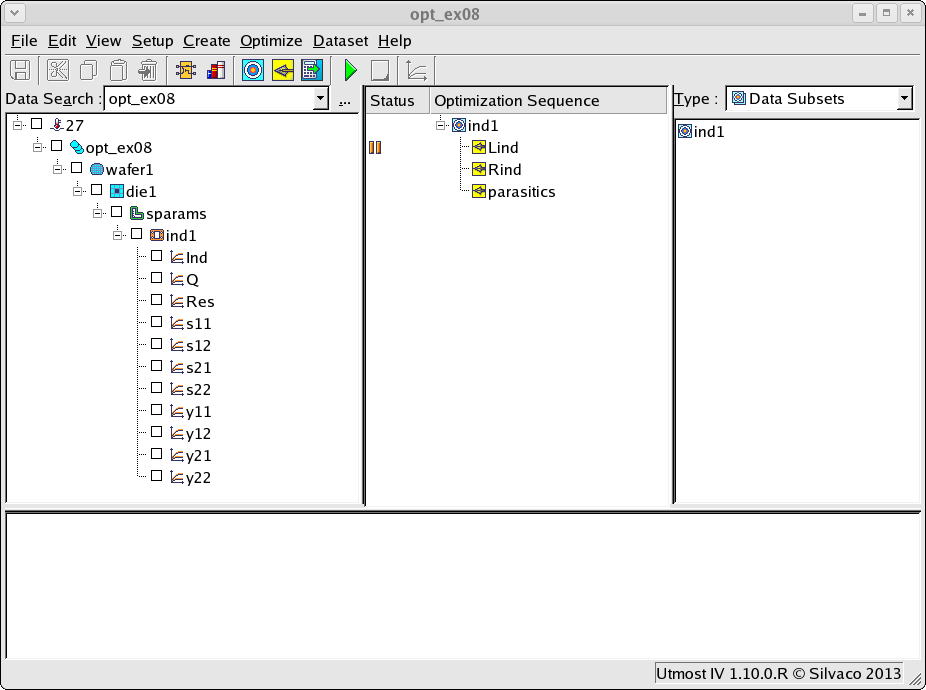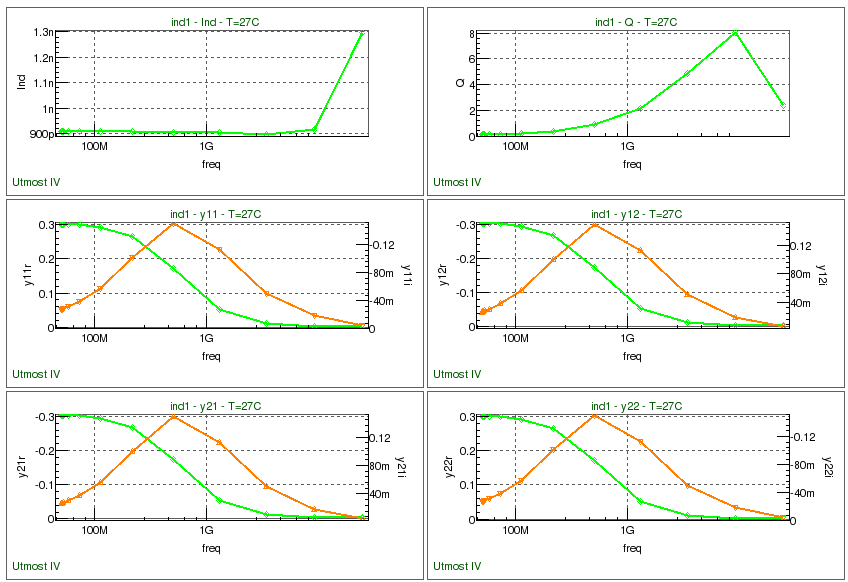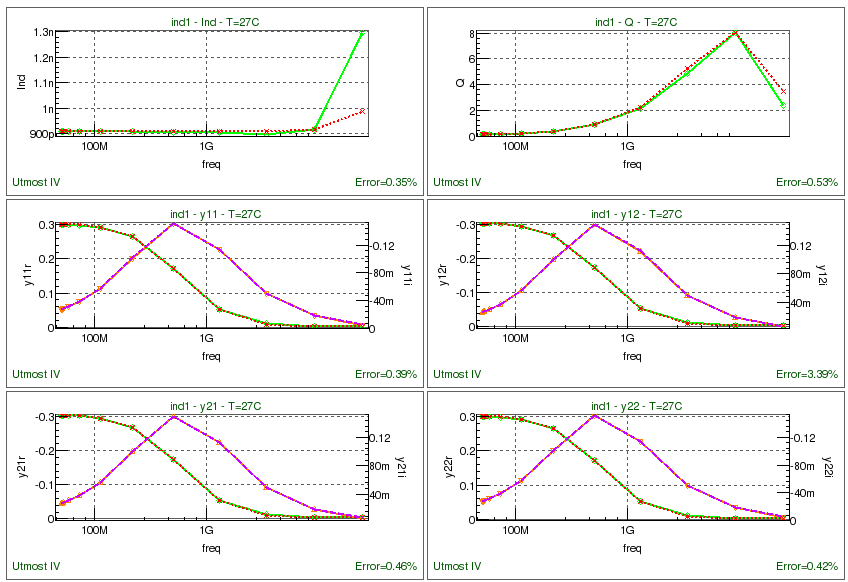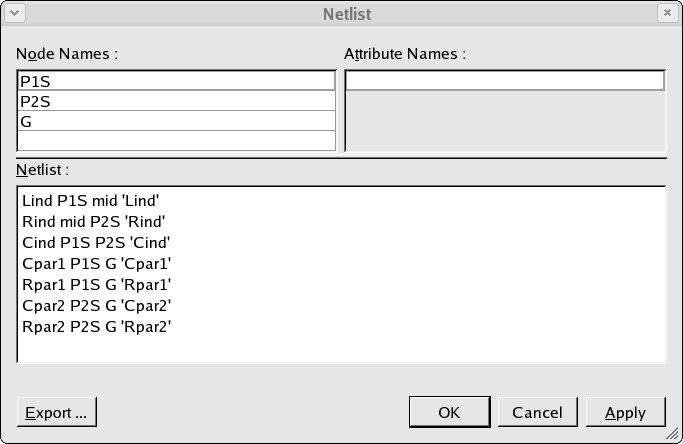opt_ex08 : Inductor Macro Model Extraction
Requires: Utmost IV, SmartSpice, SmartView
Minimum Versions: Utmost IV 1.10.6.R, SmartSpice 4.10.2.R, SmartView 2.28.2.R
This example describes how to extract a simple hybrid Pi macro=model for an RF inductor. The schematic for the hybrid Pi model is shown in opt_ex08_01.png . To extract the model, a typical s-parameter measurement is required over the frequency range of interest.
The hybrid Pi inductor macro model is a simple inductor model containing an inductance (Lind) and resistance (Rind) in series which model the low frequency behaviour of the device. The capacitance Cind models the resonant frequency of the inductor which is in parallel to the series resistance and inductance, and the four remaining components model the parasitic losses of the device.
The project file opt_ex08.prj and the data file opt_ex08.uds for this example should be loaded into your database. When opened, the project will look as shown in opt_ex08_02.png and when plotted, the example measured data will look as shown in opt_ex08_03.png . Included in the measured data are some calculated data representing the ideal inductance and quality factor for the inductor being characterised. The formulae used to calculate these values are as follows;
Ind = y21i / (2 * 3.14159 * freq * y21m*y21m)
Q = (-1) * y11i / y11r
The optimization sequence, which fully automates the extraction of this hybrid Pi inductor macro model example, has three sections.The first section takes the low frequency calculated inductance data and extracts the value of the series inductance. The second section takes the low frequency data and extracts the value of the series resistance of the device. The third section looks at all of the data including the high frequency data and extracts the parasitic loss and resonant circuit element values.
On completion of the sequence, the measured versus simulated characteristics should be as shown in opt_ex08_04.png . The model params for the individual hybrid Pi circuit elements can then be exported into an external model library file as shown in the output file opt_ex08.lib. You also have to construct a subcircuit representing the netlist which was used for the model parameter extraction. The netlist for the hybrid Pi model is as shown in opt_ex08_05.png .
opt_ex08.lib
.LIB demo .PARAM Lind = 9.07152e-10 .PARAM Rind = 3.29719 .PARAM Cind = 3.56451e-15 .PARAM Cpar1 = 1.43449e-14 .PARAM Rpar1 = 963.065 .PARAM Cpar2 = 1.50785e-14 .PARAM Rpar2 = 974.599 .SUBCKT ind1 P1S P2S G Lind P1S mid 'Lind' Rind mid P2S 'Rind' Cind P1S P2S 'Cind' Cpar1 P1S G 'Cpar1' Rpar1 P1S G 'Rpar1' Cpar2 P2S G 'Cpar2' Rpar2 P2S G 'Rpar2' .ENDS .ENDL demo
opt_ex08.uds
Utmost IV CSV Data Logfile Format Version 1.0 Copyright (c) 1984 - 2016, Silvaco, Inc. All rights reserved DataSetStart DataSetName, sparams MeasurementType, AC BatchName, opt_ex08 WaferName, wafer1 DieName, die1 GroupName, group1 DeviceName, ind1 Temperature, 27 FabDate, 11 Jun 2007 UserDate, 11 Jun 2007 NodeNames, P1S P2S G ACPort, 1, P1S, G, 0, 0, 0 ACPort, 2, P2S, G, 0, 0, 0 Sweep, 1, freq, LIST List, 1 5e+07 5.00002e+07 5.00009e+07 5.00027e+07 5.00075e+07 5.00206e+07 5.00563e+07 5.01532e+07 5.04166e+07 5.11326e+07 5.30789e+07 5.83697e+07 7.27513e+07 1.11845e+08 2.18112e+08 5.06975e+08 1.29219e+09 3.42662e+09 9.22859e+09 2.5e+10 Constant, V, G, 0 Constant, V, P1S, 0 Constant, V, P2S, 0 Function, Ind, y21i / (2 * 3.14159 * freq * y21m*y21m) Function, Q, (-1) * y11i / y11r Function, Res, (-1) * y21r / (y21m * y21m) Plot, Ind, XY (LOG LIN), freq, Ind Plot, Q, XY (LOG LIN), freq, Q Plot, Res, XY (LOG LIN), freq, Res Plot, s11, XYY (LOG LIN LIN), freq, s11r, s11i Plot, s12, XYY (LOG LIN LIN), freq, s12r, s12i Plot, s21, XYY (LOG LIN LIN), freq, s21r, s21i Plot, s22, XYY (LOG LIN LIN), freq, s22r, s22i Plot, y11, XYY (LOG LIN LIN), freq, y11r, y11i Plot, y12, XYY (LOG LIN LIN), freq, y12r, y12i Plot, y21, XYY (LOG LIN LIN), freq, y21r, y21i Plot, y22, XYY (LOG LIN LIN), freq, y22r, y22i DataArray, s11i 0.00176454 0.00176373 0.00176361 0.00176356 0.00176376 0.00176421 0.00176549 0.00176891 0.00177817 0.00180347 0.0018721 0.00205851 0.00256611 0.00394615 0.00770766 0.0180815 0.0484333 0.143189 0.343996 0.18128 DataArray, s11r 0.0319101 0.0319101 0.0319101 0.0319101 0.0319101 0.0319101 0.0319101 0.0319101 0.0319101 0.03191 0.0319096 0.031909 0.0319055 0.0318921 0.0318289 0.0314871 0.0302976 0.0444911 0.212029 0.781562 DataArray, s12i -0.00357507 -0.00357489 -0.00357513 -0.0035754 -0.00357571 -0.00357667 -0.00357919 -0.00358612 -0.00360498 -0.00365614 -0.0037953 -0.00417381 -0.00520166 -0.00799509 -0.0155735 -0.0359546 -0.0880786 -0.203302 -0.427343 -0.431355 DataArray, s12r 0.968061 0.968061 0.968061 0.968061 0.968061 0.968061 0.968061 0.968061 0.968061 0.96806 0.968058 0.968053 0.968036 0.967969 0.967649 0.965778 0.954586 0.905583 0.71257 0.106863 DataArray, s21i -0.00357519 -0.003575 -0.0035752 -0.00357545 -0.00357576 -0.00357671 -0.00357924 -0.00358617 -0.00360504 -0.00365619 -0.00379536 -0.00417387 -0.00520173 -0.00799522 -0.0155738 -0.0359553 -0.088079 -0.203257 -0.426224 -0.402043 DataArray, s21r 0.968061 0.968061 0.968061 0.968061 0.968061 0.968061 0.968061 0.968061 0.968061 0.96806 0.968058 0.968053 0.968036 0.967969 0.967649 0.965779 0.954596 0.905614 0.712463 0.102915 DataArray, s22i 0.00176708 0.00176623 0.00176606 0.00176596 0.00176617 0.00176661 0.0017679 0.00177132 0.00178059 0.00180592 0.00187466 0.00206128 0.00256959 0.00395153 0.00771838 0.0181089 0.0485347 0.143696 0.346015 0.200284 DataArray, s22r 0.03191 0.03191 0.03191 0.03191 0.03191 0.03191 0.03191 0.0319099 0.0319099 0.0319098 0.0319094 0.0319089 0.0319053 0.0318914 0.0318261 0.0314711 0.0302023 0.0441483 0.210886 0.782487 DataSetFinish






